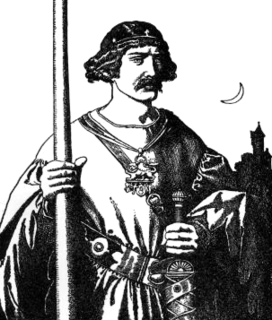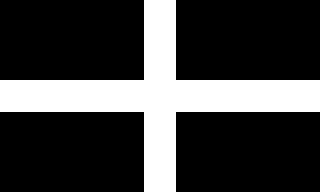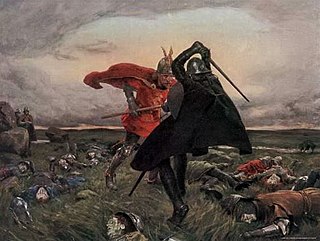Annwn, Annwfn, or Annwfyn is the Otherworld in Welsh mythology. Ruled by Arawn, it was essentially a world of delights and eternal youth where disease was absent and food was ever-abundant. It became identified with the Christian afterlife in paradise.
In Welsh mythology, Gwythyr ap Greidawl was a rival of Gwyn ap Nudd, a deity connected with the otherworld. In the Middle Welsh prose tale Culhwch ac Olwen, he is named as a member of Arthur's retinue and takes part in the quest to win the hand of Olwen for Arthur's cousin, Culhwch. Gwthyr would join Arthur on a journey to Pennant Gofid in Hell to retrieve the blood of the witch Orddu. His father is Greidawl Galldonyd, a fellow knight in Arthur's court. In Bonedd yr Arwyr, his genealogy is given as Gwythyr son of Greidawl the son of Enfael the son of Deigyr the son of Dyfnwal the son of Ednyfed the son of Maxen the son of Llywelyn. The Welsh Triads name him as the father of Arthur's second wife, also named Gwenhwyfar.

Brân the Blessed is a giant and king of Britain in Welsh mythology. He appears in several of the Welsh Triads, but his most significant role is in the Second Branch of the Mabinogi, Branwen ferch Llŷr. He is a son of Llŷr and Penarddun, and the brother of Brânwen, Manawydan, Nisien and Efnysien. The name "Brân" in Welsh is usually translated as crow or raven.

Sir Bedivere is one of the earliest characters to be featured in the Matter of Britain, originally appearing in a number of early Welsh texts in which he is named as Bedwyr Bedrydant. In the later versions, he is described as being the Knight of the Round Table of King Arthur who serves as Arthur's marshal and eventually returns Excalibur to the Lady of the Lake. He is frequently associated with his brother Sir Lucan and his cousin Sir Griflet, as well as with Sir Kay.
The Thirteen Treasures of the Island of Britain are a series of items in late medieval Welsh tradition. Lists of the items appear in texts dating to the 15th and 16th centuries. Most of the items are placed in the Hen Ogledd or "Old North", the Brittonic-speaking parts of what is now southern Scotland and Northern England; some early manuscripts refer to the whole list specifically as treasures "that were in the North". The number of treasures is always given as thirteen, but some later versions list different items, replacing or combining entries to maintain the number. Later versions also supplement the plain list with explanatory comments about each treasure.
Peredur is the name of a number of men from the boundaries of history and legend in sub-Roman Britain. The Peredur who is most familiar to a modern audience is the character who made his entrance as a knight in the Arthurian world of Middle Welsh prose literature.
This is a bibliography of works about King Arthur, his related world, family, friends or enemies. This bibliography includes works that are notable or are by notable authors.

Sir Yvain, also known as Ywain, Owain, Uwain(e), Ewaine, etc., is a knight of the Round Table in Arthurian legend, wherein he is often the son of King Urien of Gorre and the sorceress Morgan le Fay. The historical Owain mab Urien, on whom the literary character is based, was the king of Rheged in Great Britain during the late 6th century.
Gwallog ap Lleenog was a hero of the Hen Ogledd. He has long been considered a probable sixth-century king of the sub-Roman state of Elmet in the Leeds area of modern Yorkshire, though some more recent scholarship would identify him more tentatively simply as a 'king of an unidentified region in the north'.
Cuthwulf, also sometimes Cutha, was the third son of Cuthwine, and consequently a member of the House of Wessex. Although a member of the direct male line from Cynric to Egbert, Cuthwulf was never king. He is said to have been born circa 592, and his death date is unknown.
Events from the 7th century in England.
Bledric ap Custennin was a 6th and 7th century ruler of Dumnonia.

Armes Prydein is an early 10th-century Welsh prophetic poem from the Book of Taliesin.
In Welsh tradition, Hueil mab Caw was a Pictish warrior and traditional rival of King Arthur's. He was one of the numerous sons of Caw of Prydyn, and brother to Saint Gildas.
Drudwas ap Tryffin is a knight of King Arthur's court in early Arthurian mythology and the owner of the magical Adar Llwch Gwin. His father, Tryffin, is described as the king of Denmark, while his sister Erdudwyl is one of Arthur's mistresses.
According to Welsh tradition, Afaon fab Taliesin was the son of the bard Taliesin and a member of King Arthur's retinue. He appears both in the Welsh Triads and in the medieval Arthurian tale Breuddwyd Rhonabwy.

Caradoc Vreichvras was a semi-legendary ancestor to the kings of Gwent. He may have lived during the 5th or 6th century. He is remembered in the Matter of Britain as a Knight of the Round Table, under the names King Carados and Carados Briefbras.














